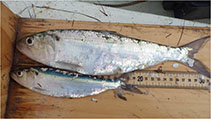| Family: |
Alosidae (Shads and Sardines) |
| Max. size: |
51 cm SL (male/unsexed); max. reported age: 4 years |
| Environment: |
pelagic-neritic; freshwater; brackish; marine, anadromous |
| Distribution: |
Western Central Atlantic: Gulf of Mexico (northern part, from the Mississippi delta eastward to the Choctawhatchee River in Florida; also in rivers from Iowa to Arkansas and across to West Virginia). Status of threat from Ref. 11858. |
| Diagnosis: |
Dorsal spines (total): 0-0; Anal spines: 0-0. Body moderately compressed, belly with distinct keel of scutes. Lower jaw steeply rising within mouth; no teeth present at front of jaws; upper jaw with a distinct notch. The only other shad of the Gulf of Mexico has only 20 to 24 gill rakers. Closely resembles A. aestivalis and A. pseudoharengus of Atlantic coasts, but in them the lower jaw rises very steeply in the mouth (Ref. 188). |
| Biology: |
Forms schools. Ascends rivers and streams to spawn in spring or early summer, the young presumably descending in autumn. Marketed mostly fresh. |
| IUCN Red List Status: |
Near Threatened (NT); Date assessed: 15 April 2020 (A2ac) Ref. (130435)
|
| Threat to humans: |
harmless |
Source and more info: www.fishbase.org. For personal, classroom, and other internal use only. Not for publication.

